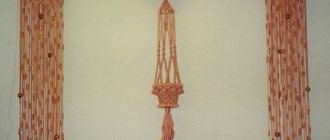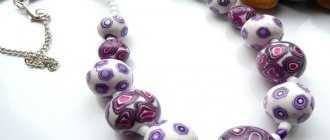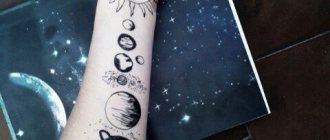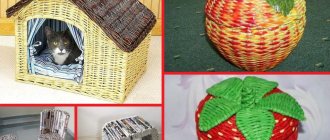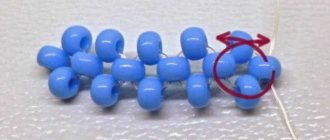Home Information Blog Tatting technique – weaving basics for beginners
Do you love lace? Probably everyone loves them. You can decorate not only dresses and blouses with lace, but also any home textiles - it’s so elegant and cute. Today we want to introduce you to the tatting technique - the process of creating lace from threads using an original technique.
If we talk about processes, then tatting knitting combines techniques from different types of needlework: here you have a crochet hook, knitting needles, and macrame, but at the same time it is something completely special. However, let's look at the technology a little more carefully - everything will become clear to you right away.
What can be done using the tatting technique
An unusual art of weaving from cords and rigid threads arose as a way of making durable openwork elements for decorative finishing of clothing or interior decoration.
Currently, in addition to the traditional use of elegant lace products, needlewomen make many unusual accessories, such as bracelets, pendants, earrings, fans, summer bags and umbrellas, as well as other cute little things.
Made from multi-colored ropes, strands and thick threads, these items retain their original shape for a long time and serve as original decorations.
Our recommendations
If you are just starting to master the tatting technique, then it is better to start with working with a needle, and then start making products with a shuttle. Try to select the simplest things for training - napkins, small pendants or earrings, spikelets, and then move on to more complex products (tiaras, hats, dresses, vases, umbrellas, toys and everything that you can come up with yourself). Decorating with bead patterns looks very beautiful on them, so if you have done beadwork before, then it will be much easier and clearer for you to understand the tatting technique.
It is easier for beginning needlewomen to learn from lessons with videos, where every moment of work is explained and shown in detail.
It is worth remembering that all parts of the future product must be tightened well and tightly so that they can maintain the shape they need. And most importantly, craftswomen will need perseverance, patience, accuracy in following the drawing and attentiveness.
Earrings tatting Earrings tatting Earrings tatting
Tatting earrings
Origin of the tatting technique
There are several controversial versions about the history of the emergence of the art of tatting:
- Weaving intricate patterns using shuttles first appeared in the East, and from there it spread to Europe along trade routes.
- Another opinion suggests that this method of knitting was invented by fishermen who made various gear for their fishery.
- Another version says that the technique was invented in one of the Catholic monasteries.
- Finally, the fourth opinion is in favor of unknown craftswomen-inventors, of whom there were many among the common people.
It is now difficult to judge what this type of needlework was like in the depths of centuries, but in the form closest to the modern one, it manifested itself in the 19th century.
European magazines from the century before last contain clothing models with recommendations for weaving openwork inserts and collars made of thick lace.
The new technique was quickly picked up by many needlewomen, for whom making beautiful lace trim using a shuttle turned out to be a simpler and faster task than sitting for a long time over thin lace with many bobbins.
Features of art
The history of the extraordinary direction of applied creativity originates in the Ancient East. It was in this simple knotted way that fishermen made their nets. Later, the art gained popularity in European countries, and the name “tatting” was invented by French fashionistas, from the word frivilite, which translated means “empty, weightless.”
Openwork bracelet and earrings made of red thread
Threads of silver and gold were used as materials for making patterned guipure. The rich outfits of the royal nobility and court ladies were decorated with cuffs, frills and collars. Today, the base material can be simple threads of cotton or linen. Such products will decorate fashionable outfits and accessories no less luxuriously. The art of tatting is often used in creating collections of original costume jewelry.
Weaving methods (instructions)
While the patterns for making patterns using the tatting method remain the same, they can be woven using a thick needle with a blunt end or a special shuttle.
Using the shuttle
To work, you need to prepare rigid threads of different colors, crochet hooks that match them in thickness, 2-3 special shuttles, scissors and a needle. Hooks are useful for connecting individual woven parts of a product, and a needle is useful if you need to unravel an unsuccessful section of the work.
- The shuttle is the only accessory for this type of needlework.
- It is made of wood, metal or plastic and is a kind of spool with a thread wound on it, which is located between two plates narrowed to the ends.
- The thread is clamped between elongated stops, which allows it to be held at the desired degree of tension.
Weaving with a needle
To perform tatting patterns, you need to select a large, “gypsy” needle, about 13 cm long, which maintains the same thickness along its entire length, without widening in the eye area.
The sharp tip can be dulled by rubbing it with sandpaper. In addition to a needle, you will need threads, scissors and a regular crochet hook.
Preparatory work
Before engaging in interesting and exciting art, we need to prepare material that will be useful to us during the execution of the actions. Necessary materials:
- Thin single hook - for connecting parts.
- Cotton, silk, linen, wool, synthetic thread. It is important that it is sliding.
- Sharp scissors.
- Thin needle.
- A long thick needle with a small eye. It is with this needle that we will produce masterpieces.
- Pebbles, beads, beads for decoration.
- Two rings and an English clasp.
master class tatting lace with a needle
Weaving material
In order to quickly master the tatting technique and clearly see all the mistakes on the fragment made, it is best for beginners to choose a thick thread of a light shade for the first steps. The quality of the threads should not be slippery or too fluffy.
Natural, slightly harsh types of simple threads, which are usually purchased for crocheting openwork items, are well suited. These include crochet or toffee made from natural cotton.
Features of thread selection
Lace can be woven from any thread, it’s all a matter of skill, imagination, and preference. But there are two requirements that must be strictly observed when selecting yarn.
To make the decoration neat and beautiful, you need to choose the right threads
Firstly, high strength indicators. When tightening elements such as rings, arcs or half-arcs, a large breaking load is placed on the thread as the knots are tightened. Secondly, it must be twisted, with a smooth, evenly colored surface. The lint prevents the knots from moving freely. Tying is an obligatory component of the process, because they can accidentally break off under strong tension or simply end. To tie the thread while continuing weaving, the knot should be as inconspicuous as possible, so as not to disrupt the magic of sophistication and special grace of the fabric. The most popular technique is the following: we connect the ends of the old thread and the new one, turning them so that a loop is formed. Until the knot is tightened, a needle is inserted into it, which moves it close to the lace.
Threads for tatting
Basic handicraft techniques (step by step)
Of the main elements of this technique, three stand out, which are called:
- Ring;
- Rounded arc;
- Decorating picot loop.
In practice, all complex patterns consist of various combinations of just three main techniques.
The entire openwork product is woven using a tatting knot, which can be double or single. To study it, you need to take a hook or a large needle and press the end of the thread against the side line of the tool from behind.
One end of the thread must be thrown over the needle, towards you, and then the piece left behind should be drawn from below and thrown from the left side through the needle, passing it symmetrically first through the loop formed.
This creates a double knot, from which work on most products begins. Pieces of different threads can be connected using the common “Hercules knot”. It is made from two pieces of different threads folded in half, in each of which the ends of one thread are passed through a loop formed by the other.
Making lace
- To understand the art of such unusual weaving, you need to understand the basics of creating just one fragment - a double knot, from which original patterns are knitted.
- Straight knot
- Reverse knot
- Beginners will master this technique quickly, since there will be no major difficulties in the learning process.
- The above technique is distinguished by the following elements created on the basis of complete knots:
It won’t take much time to master the process of creating these motifs. When you can master the techniques for performing these details, the magical world of wonderful weaving will open up, and you will begin to create the desired things that will cause admiration. Having patience, using perseverance and developed imagination, your dream will come true - you will learn how to weave tatting knitting.
Working material
An exciting creative activity will come true if you prepare the material needed in the process:
- crochet hook corresponding to the thread size
- yarn, preferably with glitter
For lace weaving, thin hooks with elongated handles and a smaller head are prepared. This device will be easy to operate. You can use those made of wood, the head can be reduced with sandpaper.
Thin and graceful lace comes out of ordinary sewing thread, but knitting with it requires concentrated attention. For beginners, it is best to use thicker yarn, ideally twisted, from which you will get even knots.
Iris or mercerized cotton may work. Having prepared everything necessary, we can begin training.
Weaving technique
This activity is very similar to the same technique of doing it with a needle, differing only in the way the thread comes out, not through the eye of the needle, but from a skein, where the yarn passes through the knots from a different direction.
Anyone who has already tried to weave with a needle will find it easy to figure out knitting. Beginners need to familiarize themselves with the technique of weaving a double knot. Using only a hook, the rings themselves are created.
But by combining this method with a simple knitting technique, you can get an excellent wicker item.
Abbreviations in tatting
To make a thing using the technique described, you need to learn to see schematic drawings and symbols.
I will describe those that are often found in schematic descriptions:
- double knot - remote control;
- pico - P.;
- pico connecting - SP;
- connecting picot with beads - BSP;
- picot with beads - BP;
- close the ring - closed;
- air loops - VP;
- arch along the inner edge - AVK.
Having familiarized ourselves with the described abbreviations, we will begin to create guipure motifs. Let's try to create a unique butterfly; you can later use it to make a pendant or earrings.
But before we begin the creative process, we will try to master the method of weaving a double knot. I provide a step-by-step master class with accompanying photos.
Step-by-step master class on creating a double knot
| Illustration | Step-by-step instruction |
| Step 1 Prepare a crochet hook. | |
| Step 2 We take the device in the right hand, and stretch the thread on two fingers of the left hand, fixing it with the little finger. | |
| Step 3 We pry the bottom thread, located on the thumb, with a tool, rise up, grabbing the top yarn, pull it up and scroll. | |
| Step 4 This creates a half knot. | |
| Step 5 The fiber is thrown onto the index finger, the knitting device is directed towards itself, it picks up the thread and tightens. | |
| Step 6 The second half-knot came out. | |
| Step 7 Two formed knots form a double knot. |
Practice a little and you will get smooth and beautiful buttonholes. Well, it's time to create further. As we proceed with the knitting manipulations, we will need a picot in the ornament.
Pico
- Pico is a loose thread between double knots that allows you to connect several motifs or to place beads.
- Four remote controls are dialed onto the device.
- Next, another remote control is knitted, but does not approach the knitted loops.
- The nodule is fixed at a distance of seven millimeters.
- Use your finger to move a small loop towards the completed knots.
- Thus, we have mastered the technique of knitting picot.
Crochet circle
Having cast all the necessary loops on the knitting tool, we then perform the following procedure:
- We hook the yarn to the little finger.
- We grab the thread and pull it through all the knots located on the device.
- The loop from the little finger is thrown onto the instrument.
- The removed buttonhole is tightened.
- We grab the loop and pull the thread through the two loops formed. Thus, we got the main element - the ring.
Butterfly using tatting technique
Having studied the basic knitting elements, we will be able to cope with the first wicker product - a butterfly. Below is a photo illustrating the scheme according to which we will create.
- Let's carefully study the description of the scheme.
- First ring: 6 DU, P, DU, P, DU, P, 6 DU, close the circle.
- Second circle: 4 remote control, P, 4 remote control, close the ring.
- We knit the third ring in the same way as the second round.
- The fourth ring is exactly the same as the first.
Having knitted the last ring and tightened the thread, we have a beautiful knitted creation in the form of a miniature butterfly. By hooking it onto the fittings for threading into the ears, we can use attractive earrings.
Having understood the weaving of simple jewelry, over time it will be possible to create more complex products.
Jewelry decorated with beads will look more beautiful and elegant, attracting attention with its airiness, lightness and extraordinary solution.
The craftswomen who create such unusual things are revered and respected because they do such painstaking work, which requires great perseverance and great attention.
Video master class “Tatting with crochet”
Source: https://podelkiruchkami.ru/frivolite-kryuchkom-dlya-nachinayushhih/
First steps in tatting technique
To the beginning, made from a double knot on a needle or hook, you can add several simple knots, making them one part of the thread on the other.
It turns out a whole segment made of identical, even knots.
Having connected the resulting chain into a ring, you need to continue knitting, making another double knot next to it on the needle. It will inevitably end up at a noticeable distance from the finished fragment, but if you tighten the thread, then only a small loop, called a “picot,” will remain between them.
- The resulting loop can be smaller or the same diameter as the first circle of knots. You can continue tying knots around it.
- To connect with other connected fragments, some picot loops are left small and loose.
The unconnected ends of the tied chains are arcs that become elements of lace if other similar elements located at different angles to each other are attached to them.
When a beginner can master simple combinations of rings and arcs, he can make beautiful objects and jewelry, decorating them with beads, rhinestones or seed beads.
Lacy splendor
Weightless collars, napkins made from motifs of different shapes, tablecloths formed by concentric circles - it would seem that all the same things can be crocheted. However, the clear pattern of rings and arcs, a characteristic feature of tatting, fascinates with its grace.
The new technique, developed by needlewomen from Russia, is based on shuttle lace and uses the same terms and basic techniques. There is also a subtype of this craft, in which the main tool is a special needle, rather than the relatively familiar shuttles, but other than this, there are no other differences in it.
Basic elements and concepts
Round shapes similar to a drop are traditionally woven with one shuttle, but weaving using the ANKARS technique has developed options with two and even three shuttles . This alone incredibly expanded the capabilities of the craftswomen. Thus, patterns for continuous weaving of repeating motifs, as well as chains of rings, have now become available.
The arc serves to connect the rings and is woven with two shuttles. This allows you to place additional elements on it. But there are also patterns consisting of only arcs, somewhat reminiscent of a spider’s web. Basically, such patterns are used in small independent appliqué elements, most often snowflakes, and also for creating lace of small (1.5-2 cm) width.
To move from one ring to another, it is not necessary to weave an arc. Sometimes they simply leave a small piece of thread - a “leg”. In particular, without using a “leg” it is impossible to create fillet meshes. Such nets are the basis for shawls, scarves, stoles, and also fill voids in large elements.
